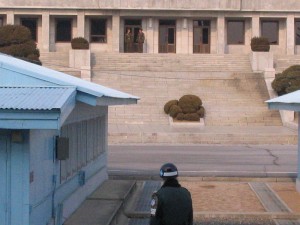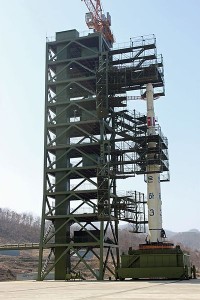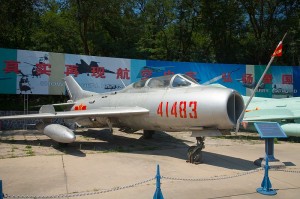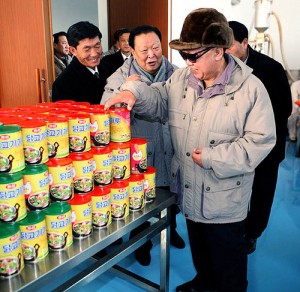ANALYSIS: North Korean Threat to Hawaii
By Nate Gaddis
Maybe Dennis Rodman is to blame.

Dennis Rodman’s basketball diplomacy doesn’t seem to be working. Image file North Korean News Agency.
The 6-foot-7, multi-colored NBA superstar recently engaged North Korea in a little basketball diplomacy, going so far as to personally meet and “hang” with its bulbous, newly-minted leader.
Kim Jong Un, who was handed the keys to North Korea’s nukes after his father hit room temperature, was seemingly impressed by Rodman, who thoughtfully praised his host in return.
Shortly after Rodman left the country, the North Koreans scrapped the roughly 60-year-old armistice that has been the basis for a tenuous but relatively peaceful existence with South Korea.
Recent UN Security Council sanctions against the country may be the more likely cause of Kim Jong Un’s recent posturing. North Korea’s leader apparently enjoyed Rodman’s company, and plans to vacation with him in August. In the meantime, Jong Un is keeping busy by threatening nuclear war.

A South Korean soldier stares at his North Korean counterparts in a neutral portion of the DMZ separating the two countries.
Hawaii residents, who share their sandy shores with the US military’s Pacific Command, tend to be a little more tuned in to North Korea’s chest-thumping than your average US mainlander. A 2009 missile test by the North Koreans had reportedly been intended to fly in the direction of Hawaii.
Given that our islands would play a central role in any conflict involving Kim Jong Un and crew, it would be wishful thinking to believe we don’t represent a glowing target for the north’s fledgling nuclear program.
But despite Jong Un’s spooky rhetoric of late, islanders shouldn’t be overly concerned. Here are a few reasons why.
Nukes Not Ready for Prime Time
Estimates of just how many warheads the North Koreans have stockpiled varies. But regardless of how many they produce, the tougher task is managing to actually hit us with one.
Although some of its closer neighbors are within range of North Korean missiles, the rogue nation has yet to produce anything that could reliably target Hawaii or the US mainland.
A perfectly-executed launch of a Taepodong 2 rocket would reportedly still fall a few hundred miles short (a range of over 4,000 miles would be necessary to grace our state’s boundaries), and though its most current technology may give it a much farther reach, pulling off such a maneuver is still thought to be beyond their ability.
Of course, that assumes a North Korean rocket would even make it halfway here. Should Japan’s ample missile defense systems fail to knock a Hawaii-bound warhead out of the sky, the US has thoughtfully spent the last couple of decades perfecting its missile defense shield for just such an occasion.
North Korean Airforce High Tech… For the 1960s
Despite spending the vast majority of their country’s wealth on its military forces, North Korea’s leaders have failed to keep pace with military technology in the West. Nowhere is this more evident than in the country’s air force.
Although North Korea reportedly possesses between 30 and 40 MIG-29 fighter aircraft (the former Soviet Union’s last, great fighter jet, which is still in service), the majority of its air force resembles a museum collection.
Any islanders worried about an air attack from Kim Jong Un’s forces can reassure themselves by glancing at a photo of a North Korean Shenyang fighter, of which hundreds are reportedly still in operation.
US Pacific Command is More Worried About Global Warming
Yes, you read that correctly. One of the pillars of America’s national security is more concerned with the effects of climate change than any potential threat from North Korea.
That assessment comes from the head of Pacific Command himself, Navy Admiral Sean J. Locklear III. Last week Friday, Locklear told an interviewer from the Boston Globe that the damage from global warming “is probably the most likely thing that is going to happen… that will cripple the security environment, probably more likely than the other scenarios we all often talk about.’’
The Kims Like Shiny Things
As Kim Jong Un is aware, launching significantly deadly ordnance in the direction of Hawaii, Japan, or any allied nation would likely invite oblivion of the aerial variety.
Most analysts agree that the North Koreans have no interest in legitimate warfare, since apart from guaranteeing their demise, it would likely limit their aristocracy’s consumption of luxury goods like Cognac. Jong Un’s father once spent $800,000 on Hennessy alone.
The Chinese are even less interested in any real trouble on the Korean peninsula, seeing a nuclear-armed North Korea as a catalyst for a regional arms race. While the Chinese were formerly loathe to level major sanctions against their ally and neighbor, they have finally begun to formally scold the North Koreans.
At the end of the day, Kim Jong Un would likely be happiest following in his father’s tradition of roaming his country, staring at North Korean-made goods with his entourage in tow. Nuclear weapons appear to be his bargaining chip in maintaining the status quo.
For Hawaiians, North Korea doesn’t appear to be a legitimate threat. Its leader’s love of shiny objects and penchant for self-preservation will hopefully keep it that way.












